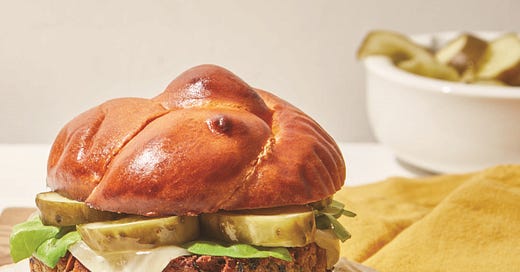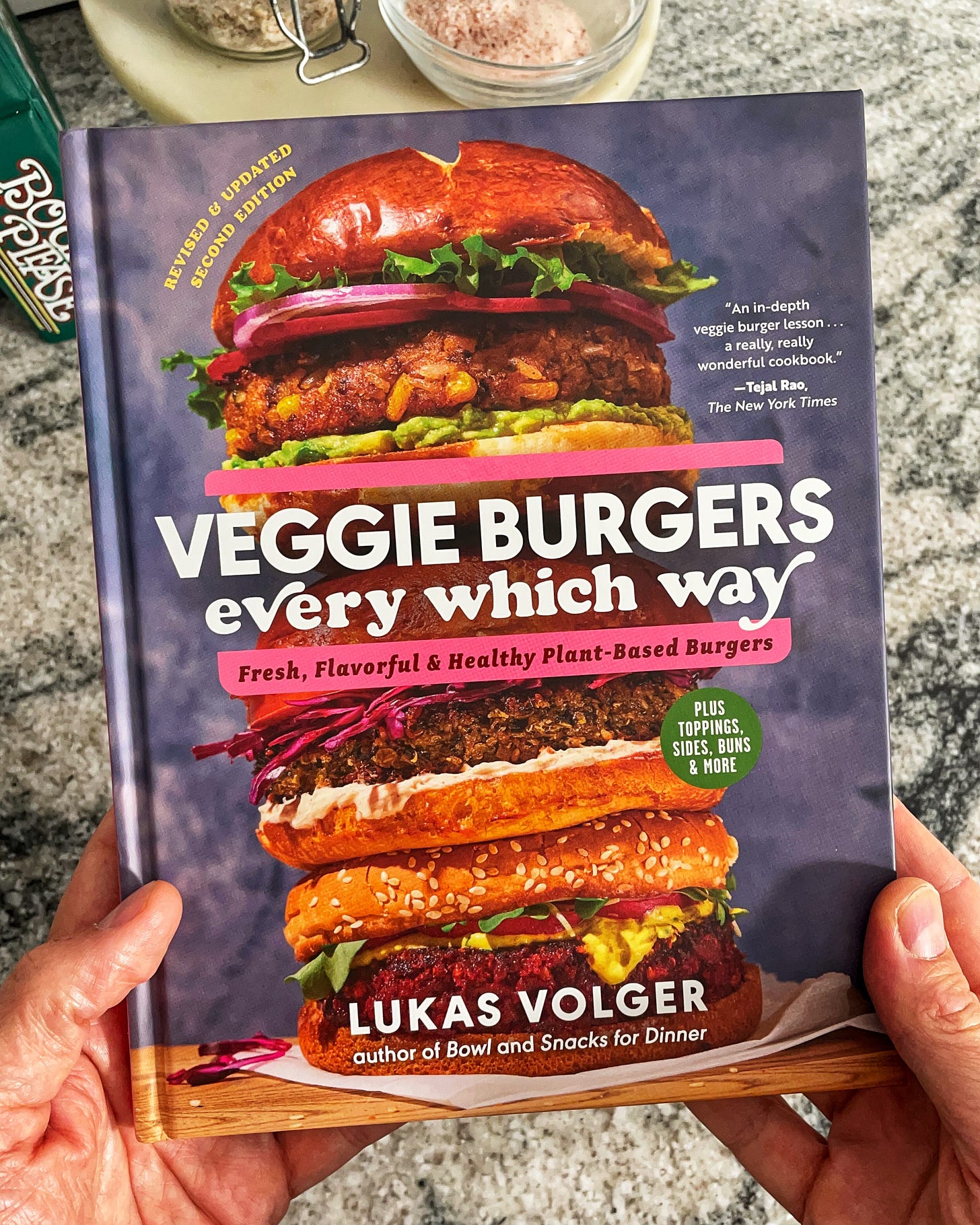
I’ve always approached cooking — and everything, to be honest — as more a student than an expert, since the part I enjoy most is the search for new discoveries. In fact, sometimes I’m taken aback by the expectation of authority that comes with being an author! But then I remind myself that yes, I have put in many hours on this topic. And while there’ll always be new things to learn, there are many lessons as well, and they ought to be shared.
I’ve learned soooo much since Veggie Burgers Every Which Way came out 13 years ago. But I was also pleasantly surprised as I revisited my original files, by how much of my thinking has stayed the same: I’ve always liked simple preparations and whole ingredients, appreciated vegetables for what they are rather than what they’re not, and thought of a recipe as part of a larger cooking habit instead of a one-off activity whose only aim is dinner on the table. I’ve always just wanted readers to cook, and to do it often.
I know people buy cookbooks for recipes, but one thing that I’ve always been trying to impart, with varying degrees of success, is a spirit of creativity. This is hard to teach because it’s much more likely learned through practice. But I want my readers to enjoy throwing together a meal from a random assortment of scraps, or recycling last night’s dinner into something new, just as much as I do. In addition to saving money and reducing waste, cooking this way is fun and delicious.
So, since this coming Tuesday marks the official publication day for the new edition of Veggie Burgers Every Which Way, I thought it a perfect opportunity to cull through the many veggie burger lessons I’ve learned and pare them down to a few essentials, which I hope you’ll apply as you start creating veggie burgers of your own.
Quickly, a few veggie burger news items:
I hope you’ll check out Alicia Kennedy’s terrific story in Foodprint, about how my book (both the old and the new edition) plug into the larger story about veggie burgers over the past 10 years. I’ll also be speaking with Foodprint for an Instagram Live chat on Wednesday, June 7, at 2pm EST. (You can follow me on Instagram here if you don’t already.)
Here’s a just-announced event for friends in New York: I’ll be flipping veggie burgers in Greenpoint at the Garden of Pride Party at Tend on Thursday, June 15th, which benefits the Audre Lourde Project. Space is limited, and tickets are for sale now.
And books will be for-real for sale this coming Tuesday! If you preordered your copy, it should be arriving very soon. If not, there’s still time!
5 Tips for Better Veggie Burgers
1. Try Cooking them Lower & Slower
In the first edition of my book, I advocated for a stovetop-plus-oven veggie burger cooking method, which I thought to be the best way to cook a burger so that it’s got a crispy exterior, and a fully cooked interior. This is still a great way to cook veggie burgers, especially for batters that are more moist, because the oven helps them dry out a bit.
But through my Made by Lukas veggie burger business, I spent many, many hours cooking off free veggie burger samples for shoppers in frigid dairy departments of grocery stores, where I learned that one way to solve for mushy veggie burgers is to just cook them bit longer, and slower, on sightly lower heat, and to even let them cool a bit before heating, during which time they firm up slightly.
So to consolidate the cooking to a skillet, first sear the exteriors on both sides, then reduce the heat and continue cooking, flipping every now and then, until firmed up when you give them a tap. Then let them cool for a few minutes, during which time they will firm up further.
2. Strive for Textural Variety
It can be tempting, especially if you’re busting out the food processor, to blitz your ingredients to a uniform texture. Try not to do that. In fact, lean into chunks of whole beans, little nuggets of roasted squash, and slivers of olives and other accents that you’ll notice as you eat them.
And for a vegetable prep method that usually cuts down on prep time, reach for your box grater. Coarsely grated carrots, parsnips, beets, sweet potatoes, and even winter squash have the advantage of both not needing to be pre-cooked in the oven, and also contribute body to the burger in the form of vegetable texture that retains some of its integrity. I love my box grater. In the universe of Veggie Burgers Every Which Way, this tip could also be called “your box grater is your BFF.”
3. Embrace Smash-Burger Style
And while we’re still talking about texture, one great method to yield a crispier style of veggie burger is to use the smash burger approach. I learned this one from my friend Ben Mims’s delicious Black Bean and Mushroom Veggie Burger, which relies only on beans for binder. The burgers are loosely shaped into patties, then added to a hot oiled pan and smooshed a bit, using an offset spatula. They’re thin and delightfully crispy.
This method works especially well for vegan burgers, where there’s no egg to help bind. By being thin and crisp and a touch fritter-ey, there’s less concern of them holding together once assembled in a bun (or served however you like; see below), and it helps to resolve the complaint of veggie burger oozing out the other side of the bun as you bite in. For best results and maximum crispiness, fry in a generous amount of fat or oil.
4. Pick a veggie. Or maybe two.
I think that one of the reasons my book so resonated when it was first published is because it dispelled the perception that you only need one veggie burger recipe. Actually, you can have 30 veggie burger recipes! And they can all be thrillingly fun and different.
That perception originates with the idea of a veggie burger being primarily a substitute — lots of recipes are a mishmash of different vegetables and have a vaguely neutral flavor profile, with the goal of being able to just swap in for hamburgers on buns at a cookout, then drench in condiments.
Thinking of a veggie burger as having its own specific star vegetable helps to make it exciting to think about, and to expand its potential as a category of food. Lean into this principle by starting with one vegetable to highlight, and then working backwards with complimentary flavors.
5. Think Beyond the Bun
This tip might be more obvious, but I think it’s worth including here. When first writing my book, I got into the habit of having the unshaped, uncooked burger mix on hand at all times, stored in the fridge in a tupperware, and in many ways I found this to be much more of a convenience for than frozen patties or any other kind of leftover veggie burger.
I could just scoop out a little bit to cook off a few sliders or a big burger, or crumble it up into a hot skillet and use in a quesadilla or scatter over a salad. It was faster, easier, fresher, and more delicious than any other way to reuse the leftovers. And it’s what inspired my “ready-to-shape” Made by Lukas veggie burger mixes.
It led me to prefer veggie burgers in other, non-bun formats. I love them with over a salad. I also love to make a bunch of little sliders and pack them up for snacking on a road trip, sometimes with hummus or a yogurt dip on the side. The uncooked mixes can be stuffed into dumplings, rolled into wraps and burritos, fried (or air-fried) into little falafel balls and tucked into a pita. And when you do put them in bread, they’re often just as good between slices of good toast or sandwich bread as they are a burger bun. Get creative!
That’s it for now! If you find these tips helpful, you’ll find many more of them, plus plenty of recipes, in my book.





I love your approach to cooking. I just stumbled across your sub stack and now I'm ordering your book 😊
Intuitive vegetarian cooking is what I do, and recipes are just ideas floating around in my head while in the shower 🤣. Thanks for the ideas you gave me with this post. I wished I had some friends who cook like you do. I just get "the eye roll" if I show slight excitement about veggie anything 🤷🏼. I totally agree about the bun. It's not needed. If it's a homemade sourdough bun with a tad of fresh milled rye....then yeah, but otherwise it's just the American addiction to fast food. I prefer slowww fooood -- enjoying every morsel of it. Looking forward to your book. 😜